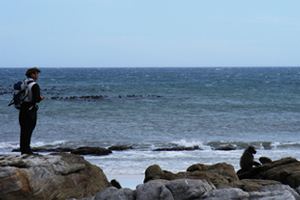Seafood on the side
17 March 2014
Contrary to popular belief, there are still baboons on the Cape Peninsula that do not raid people's homes, or even harass them at local picnic sites.
These baboons belong to the Kanonkop troop, which inhabits a 45km2 home range in the northern part of the Cape of Good Hope section of Table Mountain National Park. They feed only on natural foods, including various plants, as well as marine invertebrates such as mussels and limpets.
According to studies performed elsewhere, primates prefer foods that are rich in proteins. The Kanonkop baboons might therefore be expected to make extensive use of marine food resources.
During the course of my PhD I've studied the ecology of this troop in an attempt to determine how much marine food they eat, and how this affects other aspects of their behaviour.
I collected data through behavioural observation and stable isotope analysis (a chemical analysis of food samples, baboon hair and faecal samples) to determine the ratios of stable carbon and nitrogen isotopes in these materials. These ratios are then used as input for mathematical models that provide estimates of the proportional contributions of different foods to the baboons' diet.
Behavioural observations indicate that the Kanonkop baboons marine-forage frequently (every two to three days depending on the season), but do not spend a great deal of time feeding in the marine intertidal zone.
As a percentage of feeding time available to baboons, time spent marine-foraging does not exceed 7% in any season. The seasonal observation-based estimates of marine foraging are supported by the results of the isotope-based models, which suggest that the marine foods contribute 0-10% in different seasons.
These values are surprisingly low, and suggest that some environmental factors may be limiting the exploitation of marine foods by baboons. I therefore used statistical analyses to determine whether environmental factors affect marine foraging.
The results of the analyses suggest that bout duration, and the numbers of animals marine-foraging during bouts, both decrease with increasing tide height, wave height and wind speed.
I am in the process of modelling baboons' behaviour to better understand what might be driving or limiting marine foraging in these baboons.
 This work is licensed under a Creative Commons Attribution-NoDerivatives 4.0 International License.
This work is licensed under a Creative Commons Attribution-NoDerivatives 4.0 International License.
Please view the republishing articles page for more information.










